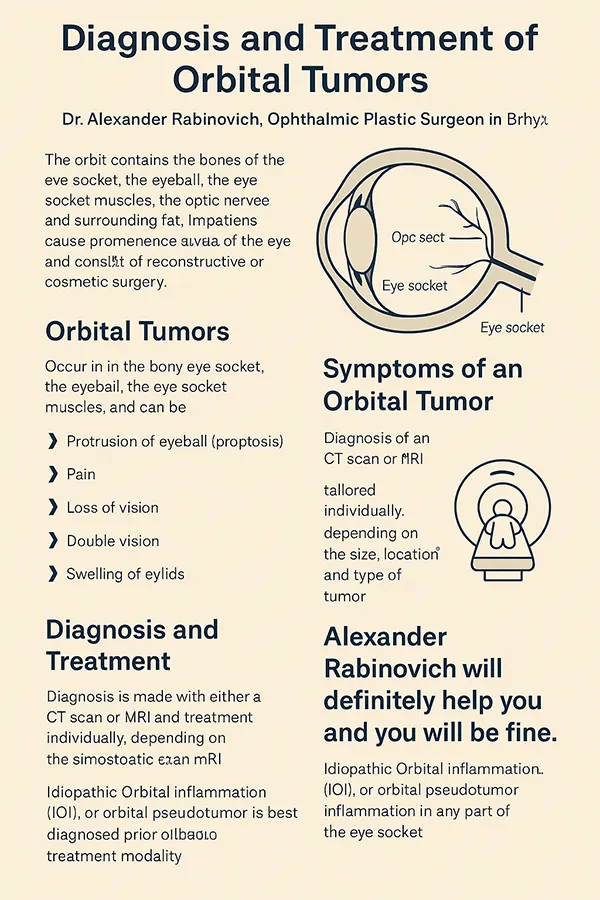The orbit is a complex anatomical space that surrounds and protects the eye. It contains the eyeball, the surrounding muscles, the optic nerve, fat, and the bones of the eye socket. When something goes wrong in this area — whether it’s inflammation, trauma, or a tumor — it can seriously affect how you see and how your face looks.
Orbital tumors are among the most serious conditions affecting the eye socket. They can appear in both adults and children, and may be either benign (non-cancerous) or malignant (cancerous). But no matter how frightening the symptoms may seem — pain, swelling, vision changes, or eye protrusion — help is available.
Dr. Alexander Rabinovich, an experienced ophthalmic plastic surgeon based in Brooklyn, New York, specializes in diagnosing and treating orbital tumors and related conditions. His patients trust him not just for his surgical expertise, but also for his careful, reassuring approach. He takes the time to explain every step of the process — and makes sure you never feel alone.
What Are Orbital Tumors?
Orbital tumors grow in the bony eye socket, the space behind the eyeball. They vary widely in appearance, cause, and severity. Some grow slowly and cause only subtle symptoms, while others may appear rapidly and require urgent treatment.

In Children
- Dermoid cysts and capillary hemangiomas are the most common benign orbital tumors.
- Rhabdomyosarcoma is the most common malignant orbital tumor in children. It often appears suddenly, with symptoms such as pain, swelling of the eyelids, and forward displacement of the eye (a condition called proptosis). This tumor is aggressive and needs immediate medical attention.
In Adults
- Orbital lymphomas are the most frequently occurring malignant tumors in the orbit in adults. These require careful diagnosis and often a coordinated treatment plan, sometimes involving oncology.
Symptoms of an Orbital Tumor
If you experience any of the following, you should see a specialist promptly:
- Bulging of the eye (proptosis)
- Loss of vision
- Double vision
- Eyelid swelling
- Eye pain
These symptoms may not always indicate a tumor, but they do require a thorough evaluation.
Diagnosing Orbital Tumors
Accurate diagnosis is essential and often involves:
- CT Scan – for detailed bone and tissue structure.
- MRI – for a more comprehensive view of soft tissue and nerve involvement.
- Comprehensive clinical exam – to correlate imaging findings with physical symptoms.
Dr. Rabinovich uses advanced imaging and careful physical assessments to determine the exact nature of the problem. He will discuss all results in clear terms, so you understand your diagnosis completely.
Conditions That Mimic Orbital Tumors
Not every orbital mass is a tumor. Some inflammatory or structural conditions may look similar at first but are treated differently.
Idiopathic Orbital Inflammation (IOI)
Also known as orbital pseudotumor, this is a non-cancerous inflammation that can affect any part of the orbit — muscles, glands, or fat. It often appears suddenly, with:
- Eye pain
- Redness
- Swelling around the eye
- Sometimes vision changes
Though benign, IOI can be aggressive and painful. It’s usually treated successfully with oral or IV corticosteroids, and accurate diagnosis through MRI or CT is essential.
Orbital Fat Prolapse
This benign condition is caused by a weakening of the orbital septum (the membrane that holds back the fat), allowing yellow fat to bulge out, usually in the outer corners of the eyes.
- It can be mistaken for a growth but is not dangerous.
- Treatment is a simple outpatient surgery to remove the prolapsed fat and restore a normal appearance.
Dermoid Cysts
These are developmental cysts that often appear near the eyebrow in young children. They may contain mature tissues such as skin, hair, or even bone or teeth.
- Completely benign, but if left untreated, they can become inflamed or rupture.
- Treatment is surgical removal, ideally in one piece to prevent recurrence or inflammation.
How Dr. Rabinovich Treats Orbital Tumors
Dr. Rabinovich develops a personalized treatment plan for every patient, depending on the tumor’s type, size, and location. Treatment may include:
- Observation for small, slow-growing, or benign tumors
- Surgical removal for accessible tumors that affect vision or cause discomfort
- Collaboration with oncologists for malignant tumors requiring chemotherapy or radiation
- Reconstructive surgery, if the tumor affects the appearance or structure of the orbit
Most importantly, Dr. Rabinovich is known for his calm and thorough approach, especially with complex or urgent cases. He balances medical precision with genuine compassion, making patients feel safe and understood.
Why Choose Dr. Alexander Rabinovich
Located in Brooklyn, New York, Dr. Rabinovich has years of experience in orbital surgery and reconstruction. His patients appreciate not just the results, but how they were treated — with kindness, clarity, and professionalism.
If you or your child has symptoms that may be related to an orbital tumor, don’t wait. Dr. Rabinovich will guide you through every step of diagnosis and treatment. With the right care, most orbital conditions — even tumors — are treatable.
You are not alone. With expert care, you can recover — and see clearly again.
Book your consultation today through our website or find us on ZocDoc.

